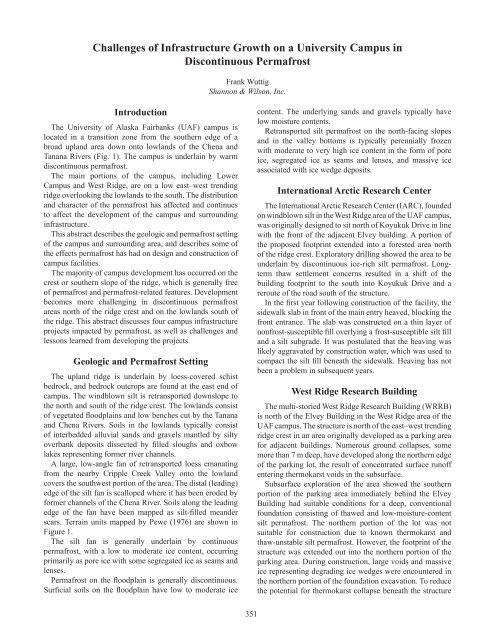Ninth International Conference on Permafrost ... - IARC Research
Ninth International Conference on Permafrost ... - IARC Research
Ninth International Conference on Permafrost ... - IARC Research
Create successful ePaper yourself
Turn your PDF publications into a flip-book with our unique Google optimized e-Paper software.
Challenges of Infrastructure Growth <strong>on</strong> a University Campus inDisc<strong>on</strong>tinuous <strong>Permafrost</strong>Frank WuttigShann<strong>on</strong> & Wils<strong>on</strong>, Inc.Introducti<strong>on</strong>The University of Alaska Fairbanks (UAF) campus islocated in a transiti<strong>on</strong> z<strong>on</strong>e from the southern edge of abroad upland area down <strong>on</strong>to lowlands of the Chena andTanana Rivers (Fig. 1). The campus is underlain by warmdisc<strong>on</strong>tinuous permafrost.The main porti<strong>on</strong>s of the campus, including LowerCampus and West Ridge, are <strong>on</strong> a low east–west trendingridge overlooking the lowlands to the south. The distributi<strong>on</strong>and character of the permafrost has affected and c<strong>on</strong>tinuesto affect the development of the campus and surroundinginfrastructure.This abstract describes the geologic and permafrost settingof the campus and surrounding area, and describes some ofthe effects permafrost has had <strong>on</strong> design and c<strong>on</strong>structi<strong>on</strong> ofcampus facilities.The majority of campus development has occurred <strong>on</strong> thecrest or southern slope of the ridge, which is generally freeof permafrost and permafrost-related features. Developmentbecomes more challenging in disc<strong>on</strong>tinuous permafrostareas north of the ridge crest and <strong>on</strong> the lowlands south ofthe ridge. This abstract discusses four campus infrastructureprojects impacted by permafrost, as well as challenges andless<strong>on</strong>s learned from developing the projects.Geologic and <strong>Permafrost</strong> SettingThe upland ridge is underlain by loess-covered schistbedrock, and bedrock outcrops are found at the east end ofcampus. The windblown silt is retransported downslope tothe north and south of the ridge crest. The lowlands c<strong>on</strong>sistof vegetated floodplains and low benches cut by the Tananaand Chena Rivers. Soils in the lowlands typically c<strong>on</strong>sistof interbedded alluvial sands and gravels mantled by siltyoverbank deposits dissected by filled sloughs and oxbowlakes representing former river channels.A large, low-angle fan of retransported loess emanatingfrom the nearby Cripple Creek Valley <strong>on</strong>to the lowlandcovers the southwest porti<strong>on</strong> of the area. The distal (leading)edge of the silt fan is scalloped where it has been eroded byformer channels of the Chena River. Soils al<strong>on</strong>g the leadingedge of the fan have been mapped as silt-filled meanderscars. Terrain units mapped by Pewe (1976) are shown inFigure 1.The silt fan is generally underlain by c<strong>on</strong>tinuouspermafrost, with a low to moderate ice c<strong>on</strong>tent, occurringprimarily as pore ice with some segregated ice as seams andlenses.<strong>Permafrost</strong> <strong>on</strong> the floodplain is generally disc<strong>on</strong>tinuous.Surficial soils <strong>on</strong> the floodplain have low to moderate icec<strong>on</strong>tent. The underlying sands and gravels typically havelow moisture c<strong>on</strong>tents.Retransported silt permafrost <strong>on</strong> the north-facing slopesand in the valley bottoms is typically perennially frozenwith moderate to very high ice c<strong>on</strong>tent in the form of poreice, segregated ice as seams and lenses, and massive iceassociated with ice wedge deposits.<str<strong>on</strong>g>Internati<strong>on</strong>al</str<strong>on</strong>g> Arctic <strong>Research</strong> CenterThe <str<strong>on</strong>g>Internati<strong>on</strong>al</str<strong>on</strong>g> Arctic <strong>Research</strong> Center (<strong>IARC</strong>), founded<strong>on</strong> windblown silt in the West Ridge area of the UAF campus,was originally designed to sit north of Koyukuk Drive in linewith the fr<strong>on</strong>t of the adjacent Elvey building. A porti<strong>on</strong> ofthe proposed footprint extended into a forested area northof the ridge crest. Exploratory drilling showed the area to beunderlain by disc<strong>on</strong>tinuous ice-rich silt permafrost. L<strong>on</strong>gtermthaw settlement c<strong>on</strong>cerns resulted in a shift of thebuilding footprint to the south into Koyukuk Drive and areroute of the road south of the structure.In the first year following c<strong>on</strong>structi<strong>on</strong> of the facility, thesidewalk slab in fr<strong>on</strong>t of the main entry heaved, blocking thefr<strong>on</strong>t entrance. The slab was c<strong>on</strong>structed <strong>on</strong> a thin layer ofn<strong>on</strong>frost-susceptible fill overlying a frost-susceptible silt filland a silt subgrade. It was postulated that the heaving waslikely aggravated by c<strong>on</strong>structi<strong>on</strong> water, which was used tocompact the silt fill beneath the sidewalk. Heaving has notbeen a problem in subsequent years.West Ridge <strong>Research</strong> BuildingThe multi-storied West Ridge <strong>Research</strong> Building (WRRB)is north of the Elvey Building in the West Ridge area of theUAF campus. The structure is north of the east–west trendingridge crest in an area originally developed as a parking areafor adjacent buildings. Numerous ground collapses, somemore than 7 m deep, have developed al<strong>on</strong>g the northern edgeof the parking lot, the result of c<strong>on</strong>centrated surface runoffentering thermokarst voids in the subsurface.Subsurface explorati<strong>on</strong> of the area showed the southernporti<strong>on</strong> of the parking area immediately behind the ElveyBuilding had suitable c<strong>on</strong>diti<strong>on</strong>s for a deep, c<strong>on</strong>venti<strong>on</strong>alfoundati<strong>on</strong> c<strong>on</strong>sisting of thawed and low-moisture-c<strong>on</strong>tentsilt permafrost. The northern porti<strong>on</strong> of the lot was notsuitable for c<strong>on</strong>structi<strong>on</strong> due to known thermokarst andthaw-unstable silt permafrost. However, the footprint of thestructure was extended out into the northern porti<strong>on</strong> of theparking area. During c<strong>on</strong>structi<strong>on</strong>, large voids and massiveice representing degrading ice wedges were encountered inthe northern porti<strong>on</strong> of the foundati<strong>on</strong> excavati<strong>on</strong>. To reducethe potential for thermokarst collapse beneath the structure351
















